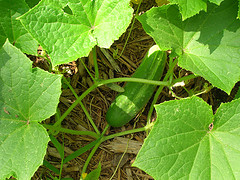Cucumbers
| Infobox on Cucumbers | |
|---|---|
| Example of Cucumbers |  |
| Freshness facts | |
| Optimum carrying temperature | 10°C to 12°C |
| Highest freezing point | -0,5°C |
| Acceptable product temp. at loading into containers | Max. 2°C above carrying temperature |
| Optimum humidity | 95% |
| Ventilation setting for containers | 25 m³/hr |
| Storage life | 1 to 2 weeks |
| Climacteric / non-climacteric | Non-climacteric |
| Ethylene production | Low |
| Ethylene sensitivity | High |
| Modified / controlled atmosphere | 3% - 5% O2; 5% - 7% CO2 |
| Potential benefits | Slight |
| Availability | |
| On demand | |
Cucumbers
Contents
Harvesting and Handling
Cucumbers are harvested at a range of developmental stages. Depending on cultivar and temperature, the time from flowering to harvest may be 55 to 60 days. Generally fruit are harvested at a slightly immature stage, near full size but before seeds fully enlarge and harden. Immature fruit are green at the edible stage, except in a few cultivars where they are white or yellow. Firmness and external glossiness are also indicators of a pre-maturity condition. At proper harvest maturity, a jellylike material has begun to form in the seed cavity.
Straight, uniformly cylindrical fruit slightly tapered at both ends are of highest quality. Additional quality indices include size, freedom from growth or handling defects, freedom from decay, and lack of yellowing.
Cucumbers are listed as non-climacteric, yet there is a burst of ethylene production that precedes a rapid loss of chlorophyll in mature fruit. Most fresh-market cucumbers are packed in fiberboard boxes.
Cooling and Storage
Recommended conditions for commercial storage of cucumbers are 10 to 12°C. Storage-life is generally <14 days, with visual and sensory quality rapidly declining thereafter.
Cucumbers are very susceptible to physiological chilling damage, which occurs at temperatures <10°C. Chilling damage manifests itself initially in soft, water-soaked, easily depressed spots on the skin; this is later followed by the discharge of liquid and detachment of the epidermal layers. Affected cucumbers rapidly become glassy and tasteless. A bacterial and/or fungal secondary infection may occur at the injured points.
Travel temperatures higher than approx. 12°C reduce the storage life of the cargo, causing the cucumbers to turn yellow, so making them unsaleable.
Controlled atmosphere considerations
Little benefit is realized from the CA storage of cucumber fruit. Cucumbers produce very little ethylene but are sensitive to the effects of ambient ethylene which causes rapid yellowing.
Storage disorders
Alternaria rot, Anthracnose, Bacterial rots, Black spot, Blue mould, Cladosporium rot, Cottony leak, Fusarium solani, Insect damage, Phytophthora, Sour rot, Watery soft rot.











